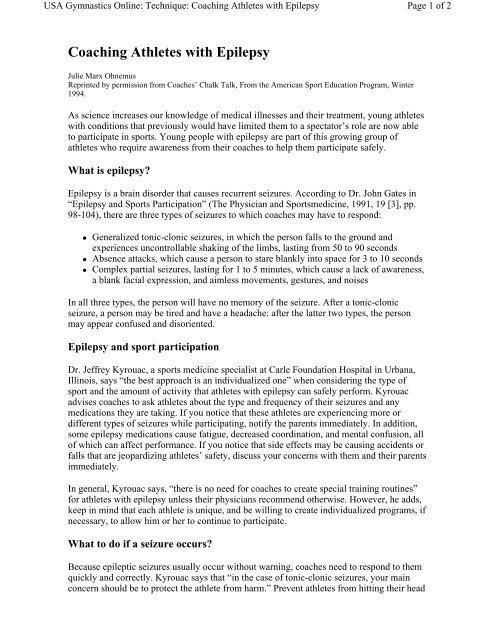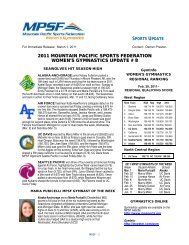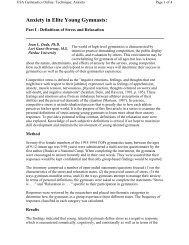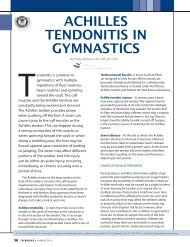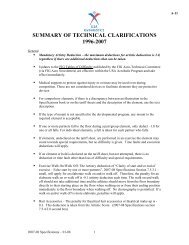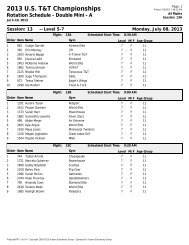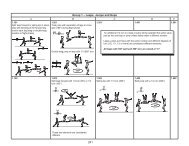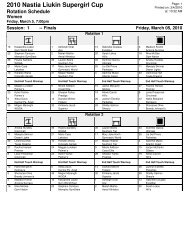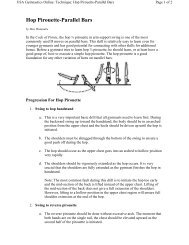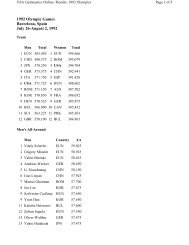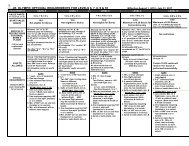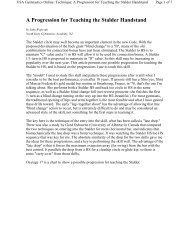Coaching Athletes with Epilepsy - USA Gymnastics
Coaching Athletes with Epilepsy - USA Gymnastics
Coaching Athletes with Epilepsy - USA Gymnastics
You also want an ePaper? Increase the reach of your titles
YUMPU automatically turns print PDFs into web optimized ePapers that Google loves.
<strong>USA</strong> <strong>Gymnastics</strong> Online: Technique: <strong>Coaching</strong> <strong>Athletes</strong> <strong>with</strong> <strong>Epilepsy</strong><br />
<strong>Coaching</strong> <strong>Athletes</strong> <strong>with</strong> <strong>Epilepsy</strong><br />
Julie Marx Ohnemus<br />
Reprinted by permission from Coaches’ Chalk Talk, From the American Sport Education Program, Winter<br />
1994.<br />
As science increases our knowledge of medical illnesses and their treatment, young athletes<br />
<strong>with</strong> conditions that previously would have limited them to a spectator’s role are now able<br />
to participate in sports. Young people <strong>with</strong> epilepsy are part of this growing group of<br />
athletes who require awareness from their coaches to help them participate safely.<br />
What is epilepsy?<br />
<strong>Epilepsy</strong> is a brain disorder that causes recurrent seizures. According to Dr. John Gates in<br />
“<strong>Epilepsy</strong> and Sports Participation” (The Physician and Sportsmedicine, 1991, 19 [3], pp.<br />
98-104), there are three types of seizures to which coaches may have to respond:<br />
Generalized tonic-clonic seizures, in which the person falls to the ground and<br />
experiences uncontrollable shaking of the limbs, lasting from 50 to 90 seconds<br />
Absence attacks, which cause a person to stare blankly into space for 3 to 10 seconds<br />
Complex partial seizures, lasting for 1 to 5 minutes, which cause a lack of awareness,<br />
a blank facial expression, and aimless movements, gestures, and noises<br />
In all three types, the person will have no memory of the seizure. After a tonic-clonic<br />
seizure, a person may be tired and have a headache: after the latter two types, the person<br />
may appear confused and disoriented.<br />
<strong>Epilepsy</strong> and sport participation<br />
Dr. Jeffrey Kyrouac, a sports medicine specialist at Carle Foundation Hospital in Urbana,<br />
Illinois, says “the best approach is an individualized one” when considering the type of<br />
sport and the amount of activity that athletes <strong>with</strong> epilepsy can safely perform. Kyrouac<br />
advises coaches to ask athletes about the type and frequency of their seizures and any<br />
medications they are taking. If you notice that these athletes are experiencing more or<br />
different types of seizures while participating, notify the parents immediately. In addition,<br />
some epilepsy medications cause fatigue, decreased coordination, and mental confusion, all<br />
of which can affect performance. If you notice that side effects may be causing accidents or<br />
falls that are jeopardizing athletes’ safety, discuss your concerns <strong>with</strong> them and their parents<br />
immediately.<br />
In general, Kyrouac says, “there is no need for coaches to create special training routines”<br />
for athletes <strong>with</strong> epilepsy unless their physicians recommend otherwise. However, he adds,<br />
keep in mind that each athlete is unique, and be willing to create individualized programs, if<br />
necessary, to allow him or her to continue to participate.<br />
What to do if a seizure occurs?<br />
Because epileptic seizures usually occur <strong>with</strong>out warning, coaches need to respond to them<br />
quickly and correctly. Kyrouac says that “in the case of tonic-clonic seizures, your main<br />
concern should be to protect the athlete from harm.” Prevent athletes from hitting their head<br />
Page 1 of 2
<strong>USA</strong> <strong>Gymnastics</strong> Online: Technique: <strong>Coaching</strong> <strong>Athletes</strong> <strong>with</strong> <strong>Epilepsy</strong><br />
on the ground, clear the area of sharp or hard objects, don’t put anything in their mouth, and<br />
don’t attempt to restrain them—let the seizure run its course. Remain <strong>with</strong> athletes after the<br />
seizure is over until they are fully awake.<br />
According to Dr. Gates, in the case of absence attacks and complex partial seizures, you<br />
should remove harmful objects from their path or coax them away <strong>with</strong>out trying to restrain<br />
them. <strong>Athletes</strong> may be aggressive during the seizure; don’t approach them if you are alone.<br />
Remember that athletes may be confused after these types of seizures; be sure to remain<br />
<strong>with</strong> them until they are fully alert.<br />
There is usually no need to call for emergency help for athletes <strong>with</strong> known seizures unless<br />
they are having difficulty breathing, have injured themselves, or are having one seizure after<br />
another. However, athletes who have no history of seizures should be taken to a physician<br />
for further medical evaluation.<br />
Kyrouac says “there is no need to announce to the entire team the names of the athletes who<br />
have epilepsy.” Instead, devote a practice early in the season to emergency first aid, and<br />
include how to help a person having a seizure. That way athletes can choose whom they<br />
want to tell about the condition, at their own discretion, <strong>with</strong>out being singled out as<br />
“different.”<br />
The best thing coaches can do, according to Kyrouac, “is provide a supportive<br />
environment” for all their athletes. <strong>Athletes</strong> <strong>with</strong> epilepsy want to lead as normal life as<br />
possible <strong>with</strong>out being singled out for special treatment. Unless medical necessity or<br />
common sense tells you that athletes <strong>with</strong> epilepsy are endangering themselves by<br />
participating, treat them as you would any member of the team.<br />
This article appears in the April 1995 issue of Technique, Vol. 15, No. 4, p. 5.<br />
Page 2 of 2


